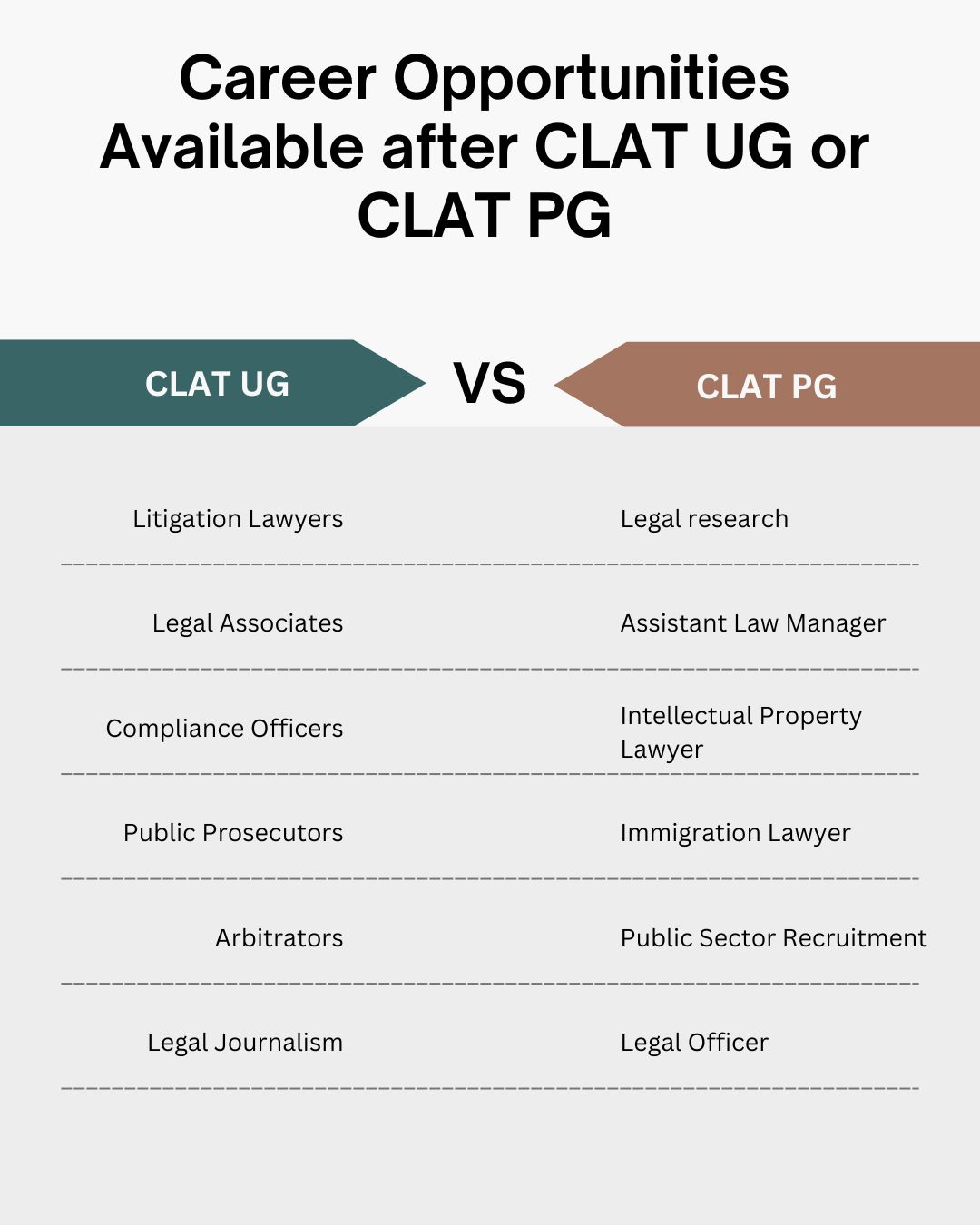The Common Law Admission Test (CLAT) is one of the most essential admission tests for students who want to pursue a career in law and further their study at top law school in India and other participating institutes. However, candidates should note that the CLAT is not a single-level exam, but rather separated into two versions, which are as follows:
| CLAT UG | This level is for those aspirants who have completed or are about to complete their Class 12 exam and want to pursue a five-year integrated law course. |
| CLAT PG | This level is for those aspirants who have graduated with an LLB degree and who want to further study at the postgraduate (LLM) level. |
While the Consortium of NLUs conducts both CLAT UG and CLAT PG tests, they differ in terms of qualifying requirements, exam structure, syllabus, and career options. Understanding the fundamental distinctions between the CLAT UG and CLAT PG tests is critical for students to determine the best way forward.
Latest Update:-
The registration period for the CLAT UG and CLAT PG exams began on August 1, 2025 and will end on October 31, 2025. Those interested in taking the CLAT UG or CLAT PG exam in 2026 should register as soon as feasible. The CLAT UG and CLAT PG 2026 exams will take place on December 7, 2025, from 2PM to 4PM.
| Dates | Events |
| August 1, 2025 | Online Registration Commenced |
| October 31, 2025 | Online Registration Concludes |
| December 7, 2025 | Exam Dates |
Two CLAT Exams, Two Different Paths and How are they Different?
While looking up or searching for CLAT Exam information, applicants must have observed that there are two different CLAT exams: CLAT UG and CLAT PG. The two different forms of the same exam are determined by the aspirant's academic path. If an aspirant is aiming for the CLAT UG 2026 exam, they must be fresh out of Class 12 and desire to become an attorney through a five-year integrated law study, whereas CLAT PG is for people who already have a law degree and want to specialize further with an LL.M.
Both exams are gateways to some of India's most famous law schools, yet their difficulty, objective, and breadth are significantly different. Understanding the differences between these two parts of the same exam is the first step toward making an informed career selection.
What are CLAT UG and CLAT PG?
CLAT UG is the undergraduate law admission exam for five-year integrated programs such B.A. LLB, BBA LLB, and B.Sc. LL.B. It is mostly aimed at students who have recently completed or are about to complete their Class 12. The exam assesses students' abilities in Current Affairs, English, Legal Reasoning, Logical Reasoning, and Quantitative Techniques. Clearing this exam would enable individuals to seek admission to some of India's most prestigious national law institutes, laying the groundwork for a legal career.
CLAT PG is a postgraduate-level course which is especially designed for candidates with an LL.B. or comparable law degree who want to pursue a Master of Laws (LL.M.). The emphasis here is on advanced legal knowledge, such as constitutional law, jurisprudence, and other law disciplines covered after graduation. Aside from academic development, CLAT PG scores are also frequently used by the Public Sector Undertakings (PSUs) and law firms for recruitment purposes, making it an important qualification for career advancement.
What is the Difference Between the Exam Pattern of CLAT UG and CLAT PG?
The CLAT UG and CLAT PG do not differ very much in the number of questions asked or the duration within which the exam is to be conducted. But the main difference between CLAT UG and CLAT PG lies in the syllabus of both exams and their eligibility criteria. Both papers allow the candidates to complete their exam within the stipulated time of 120 minutes or 2 hours. And the number of questions asked in both CLAT UG and CLAT PG is 120 questions.
Below is the comparison table of the exam pattern of the CLAT UG and CLAT PG for the aspirants to have a better understanding of the difference:-
| Exam Pattern | CLAT UG | CLAT PG |
| Exam Duration for CLAT 2026 | 120 minutes or 2 hours | 120 minutes or 2 hours |
| Maximum Marks | 120 | 120 |
| Number of Questions | 120 | 120 |
| Marking Scheme |
|
|
| Syllabus |
|
|
Also, check:-
- List of Top Participating National Law Universities Through CLAT 2026: Check Other Important Details
Difference Between the Eligibility Criteria of CLAT UG and CLAT PG
There is a vast difference between the eligibility criteria of the CLAT UG and CLAT PG exams because of the levels at which they are conducted the exams for. Below is a comparison of the different eligibility criteria for the CLAT UG and CLAT PG exams:-
| Eligibility Criteria | CLAT UG | CLAT PG |
| Age Limit | There is no upper age limit established by the official authority to be able to appear in the CLAT UG Exam. | There is no upper age limit established by the official authority to be able to appear in the CLAT PG Exam. |
| Minimum Percentage Marks | The candidates should have cleared Class 12 from a recognised board. | The candidates should have at least completed their LL.B. degree from a recognised university before applying for the CLAT PG program |
| For those candidates who belong to the unreserved category, they should have at least scored 45% marks in class 12 from a recognised board. | For those candidates who belong to the unreserved category, they should have at least scored 50% marks or its equivalent grade. | |
| For those candidates who belong to the reserved category, such as ST, SC and PwD, they should have at least scored 40% marks in class 12 from a recognised board. | For those candidates who belong to the reserved category, such as SC, ST, and PwD, they should have at least scored 45% marks or its equivalent grade. |
Also, check:-
What are the Career Opportunities Available after CLAT UG or CLAT PG?
Once the aspirant clears the CLAT exam, whether at the undergraduate (UG) or postgraduate (PG) level, aspirants open the door to a wide range of rewarding career opportunities in the legal field and beyond. For the aspirants of the CLAT UG, the most common career options to pursue are working with a law firm, starting an independent practice or at corporate legal departments.
For the aspirants of the CLAT PG graduates, the career opportunities expand further into specialised legal roles, higher positions in corporate law, advanced research, teaching in universities or working in international organisations.
Below is the comparison table of the career opportunities available after the CLAT UG and CLAT PG degree completion:-
| CLAT UG | CLAT PG |
| Litigation Lawyers | Legal research |
| Legal Associates | Assistant Law Manager |
| Corporate Lawyers | Legal Officer |
| Intellectual Property Lawyers | Assistant Legal Advisor |
| Compliance Officers | Litigation Lawyer |
| Legal Advisors | Intellectual Property Lawyer |
| Public Prosecutors | Tax Lawyer |
| Judges | Immigration Lawyer |
| Civil Services | Legal Analyst |
| Legal Researchers | Public Sector Recruitment |
| Law Professors | Regulatory Compliance |
| Arbitrators | Legal Journalism |
| Legal Journalism | Legal Advisor |
| Social Activism | Law Professor |
| Legal Technology | Alternative Dispute Resolution |

Also, check:-
To stay updated on current trends, join the Jagran Josh Telegram community!
